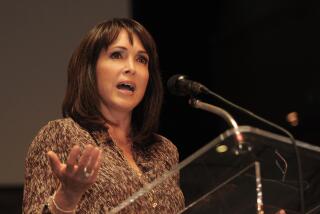R.I.P. for ‘A.M. L.A.’ : 20-Year Run on KABC Ends With Cost-Cutting Move
- Share via
LOS ANGELES — “A.M. Los Angeles,” a morning staple at KABC-TV Channel 7 for 20 years, will disappear quietly from the airwaves Friday--a victim of the economic vise that has been squeezing locally produced programming off the air for the last several years.
After a week of “Best of A.M. L.A.” reruns, the syndicated “Live With Regis and Kathie Lee” will move down the dial two notches from KCAL-9 on Oct. 7.
It isn’t the ratings that killed “A.M. L.A.” Indeed, the show regularly trounces the Channel 9 show that is replacing it.
No, according to co-host Steve Edwards, “A.M. L.A.” is an expensive piece of local programming in an era dominated by corporate profit statements.
“Cap Cities needs to cut back, and we’re where they do it,” Edwards said. “By canceling us, they get rid of a lot of bodies and roll the tape.”
Capital Cities/ABC Inc., the parent company of ABC and its owned stations, including KABC-TV, has been on a cost-cutting binge for more than a year, along with the other two major networks. And while KABC management is loath to say just how much it will save by replacing a local production with a syndicated program, it will be substantial.
“(‘A.M. L.A.’) is more expensive,” KABC programming director Vic Heman said. “I can’t give a comparison.”
A production veteran familiar with KABC’s labor and production expenses, however, put the cost of producing “A.M. L.A.” at between $7 million and $8 million annually. He said that replacing it with a syndicated series will reduce costs by at least 50% due to the elimination of a payroll of about two dozen people and three hours of daily sound-stage time.
Heman maintains that the station would not have canceled the show if it hadn’t seen a winner in “Live With Regis and Kathie Lee.” The two programs are similar in format, from the frothy celebrity interviews to the fashion and cooking segments to the happy couple who host. And Regis Philbin hosted “A.M. Los Angeles” from 1975 to 1981.
“(Returning to KABC) is what Regis has wanted to do forever,” said Edwards, who co-hosts with Tawny Little.
Philbin, whose barely contained hysteria makes him a perfect foil to the sober but giddy Kathie Lee Gifford, says he is thrilled about sliding into the 9 a.m. slot on the station where he gained popularity in the late ‘70s.
“I don’t know if I call returning to KABC a personal triumph,” Philbin said. “I had done the show in Los Angeles . . . and I always did want to try it nationally. They were pretty angry with me when I left.”
And not without reason. Philbin was lured away by NBC, which tried to duplicate the “A.M. L.A.” success in a network version, although instead of a live hour talk show, the format was a 30-minute taped program. It aired opposite “A.M. L.A.” but was canceled in four months. Philbin’s bridges at KABC had been burned, so he took his wares to the ABC station in New York, WABC, and launched yet another morning coffee klatch show in 1983. It became such a big hit that it was syndicated.
Now that he’s back on KABC, Regis has committed to doing at least two weeks a year, live, from the Los Angeles studios. What he and Kathie Lee have perfected is spontaneous “eavesdropping” on their guests, Philbin said, and that can be done to the delight of morning audiences from either coast.
Philbin prefers live and local production, too, but he maintains that tape delay and national syndication can work.
“Are they going to understand you in Kansas City? Are they going to enjoy you in Cleveland? Those are the kinds of questions we ask. So far, they have,” he answered rhetorically.
Edwards, who recently has been spending more time as a radio personality (heard afternoons over KABC-AM) than a TV host, said that he isn’t bitter about the passing of “A.M. L.A.” but that he is concerned that it bodes ill for local TV programming in general.
Even with the cooking and fashion segments that Edwards said he dreaded doing, “A.M. L.A.” was one of the final vestiges of non-news, non-syndicated, non-network programming in the Los Angeles market.
“I was spoiled,” he said. “When I started out on (KCBS’) ‘Two on the Town’ (in 1978), we did all kinds of things. I got to talk to fundamentalist Muslims in Egypt. I got to interview Buckminster Fuller. I got to take camera crews all over the world. You don’t have any of that today. Not in local programming.”
More to Read
The complete guide to home viewing
Get Screen Gab for everything about the TV shows and streaming movies everyone’s talking about.
You may occasionally receive promotional content from the Los Angeles Times.






